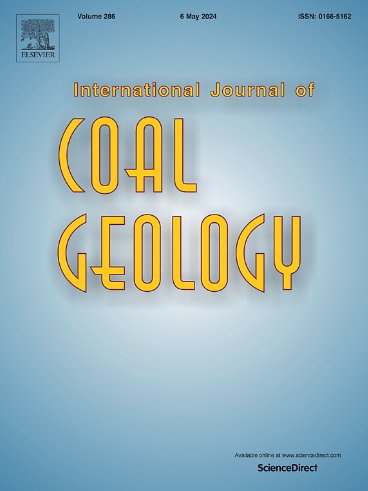华南地块煤型富锂粘土近地表锂同位素分馏与锂富集
IF 5.7
2区 工程技术
Q2 ENERGY & FUELS
引用次数: 0
摘要
地表低温沉积粘土型锂矿床是世界上三大类型的锂矿床之一;但其形成及相应的Li同位素分馏机制尚不清楚。在这项研究中,我们在中国四川盆地的晚三叠世煤型粘土锂矿床中发现了异常高的锂浓度(89.1 ppm至520 ppm)。通过原位测绘Li的分布,结合以粘土为载体的离子交换型和结构结合型Li的同位素分析,研究了Li在地球表面附近的低温迁移和富集过程。原位填图表明,锂的主要寄主为裂隙充填型和蛭状绿泥石,块状伊利石集合体和裂隙充填型paragonite中含有少量的锂。高岭石和绿泥石也在表层和层间吸收了部分锂。Li富集过程包括碰撞和俯冲背景下的碎屑(伊利石和高岭石集合体),特别是长英质火山碎屑(蛭状-高岭石),以及泥炭堆积/埋藏阶段酸性地下水与原生含锂粘土之间的水-岩相互作用。原生高岭石和伊利石被绿泥石和paragonite取代,并伴有Li同位素分馏(Δ7Li: +2.67‰~ +15.4‰)。本文章由计算机程序翻译,如有差异,请以英文原文为准。

Near surface lithium isotopic fractionation and lithium enrichment in coal-hosted Li-rich clays from the South China Block
Surficial low-temperature sedimentary clay-type Li deposit is one of three major types of Li deposits in the world; however, its formation and corresponding Li isotope fractionation mechanisms are still unclear. In this study, we demonstrate an unusually high Li concentration (89.1 ppm to 520 ppm) within a Late Triassic coal-hosted clay Li deposit from the Sichuan Basin, China. In-situ mapping of the Li distribution combined with isotopic analysis of Li occurring as clay-hosted ion-exchangeable and structurally bound Li was carried out to investigate low temperature Li migration and enrichment processes near the Earth's surface. The in-situ mapping shows that the dominant host of Li is fracture-fill and vermicular chlorite, while massive illite aggregate and fracture-fill paragonite contains lesser amounts of Li. Kaolinite and chlorite also absorbed a part of Li on surface/interlayer sites. The Li enrichment processes involve a contribution from detrital clastics (aggregate illite and kaolinite), especially felsic pyroclastics (vermicular-kaolinite) from collisional- and subduction setting, as well as the water-rock interactions during peat accumulation/burial stage between the acidic groundwater and primary Li-bearing clays. The primary kaolinite and illite was replaced with chlorite and paragonite accompanied with Li isotopic fractionation (Δ7Li: +2.67 ‰ to +15.4 ‰).
求助全文
通过发布文献求助,成功后即可免费获取论文全文。
去求助
来源期刊

International Journal of Coal Geology
工程技术-地球科学综合
CiteScore
11.00
自引率
14.30%
发文量
145
审稿时长
38 days
期刊介绍:
The International Journal of Coal Geology deals with fundamental and applied aspects of the geology and petrology of coal, oil/gas source rocks and shale gas resources. The journal aims to advance the exploration, exploitation and utilization of these resources, and to stimulate environmental awareness as well as advancement of engineering for effective resource management.
 求助内容:
求助内容: 应助结果提醒方式:
应助结果提醒方式:


